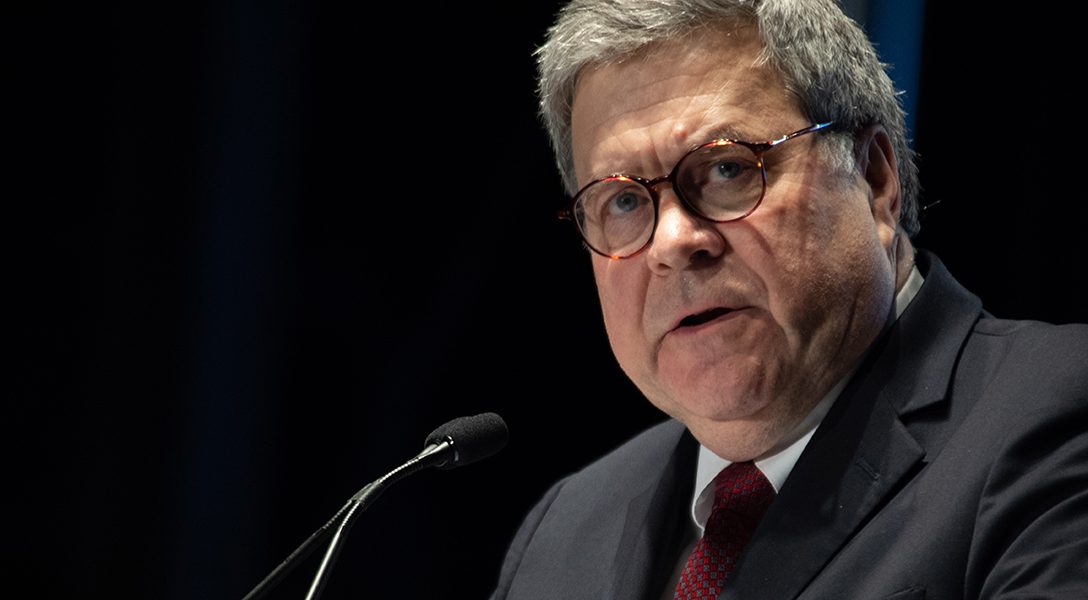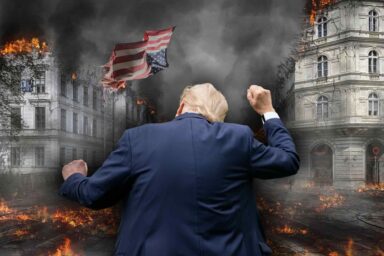Ex-CIA officer Frank Snepp recalls the forgotten past of ex-CIA officer Bill Barr — and what Barr did that was so controversial the first time he was attorney general, nearly three decades ago.
If you want to understand William Barr, President Donald Trump’s strikingly partisan and loyal attorney general who has continually assured Trump that his desired actions are perfectly legal, then you have to understand William Barr, the person.
I first got to know him in 1971 when he was just a lowly CIA analyst — and I was also working for the agency.
I wrote about this encounter in a piece for the Village Voice that traced his subsequent activities and their impact on America and the world — way back in 1992, during his first stint as attorney general. At the time he was serving George H.W. Bush (the first President Bush) and was no less controversial.
I was proud to work for the Voice, which did some of the best journalism in the world, and where Jonathan Larsen was the editor-in-chief and Russ Baker a young investigative reporter. Today, of course, Larsen is the board chairman at WhoWhatWhy and Baker is editor-in-chief.
The Voice, sadly, is now out of business, but I have given WhoWhatWhy permission to reprint this, as I believe it provides important context to the person Barr has become — and the unique role he is playing in the drama unfolding over Trump, impeachment, and the proper conduct of government officials.
The original is republished in full below. (It may also be viewed at this link.)
Bill Barr: The “Cover-Up General”
“At the center of the criticism is the chief articulator of Bush’s imperial presidency,” we reported in 1992, “the man who wrote the legal rationale for the Gulf War, the Panama invasion, and the officially sanctioned kidnapping of foreign nationals abroad.”
by Frank Snepp
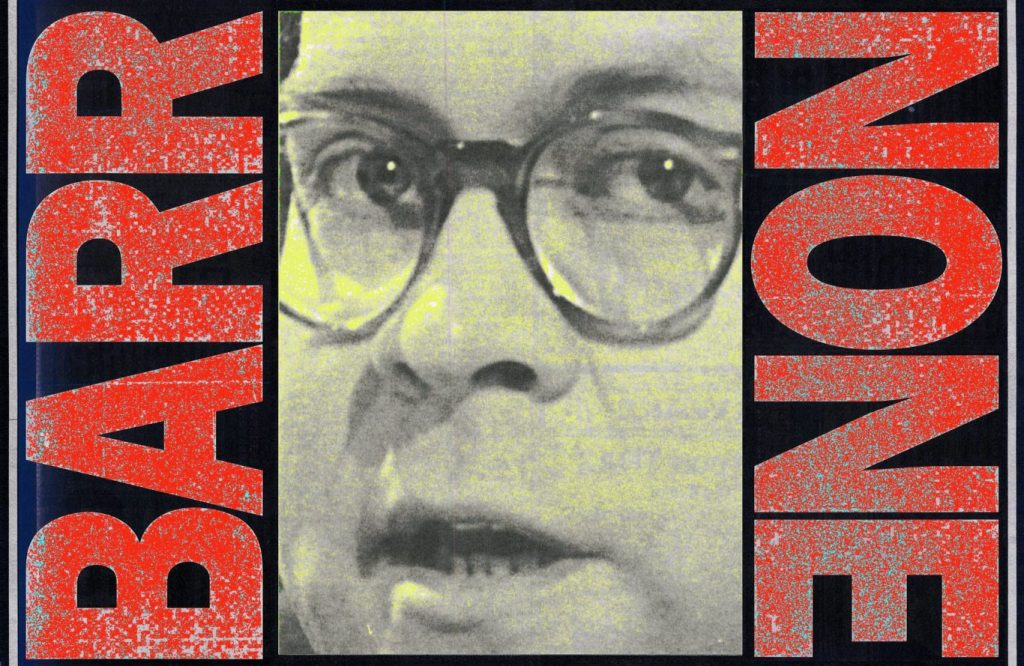
Attorney General William Barr Is the Best Reason to Vote for Clinton
October 27, 1992
A federal judge accuses the Justice Department of trying to “shape” a case involving illegal loans to Iraq. The House Judiciary Committee blasts federal attorneys for compromising their reputation for impartiality in the investigation of a computer-software theft. CIA officials charge a deputy attorney general with advocating the suppression of evidence in a sensitive sentencing hearing.
To even the most avid scandalmonger, these may sound like the ravings of a fevered Orwellian imagination. But in fact they are all part of a litany of wrongdoing leveled at George Bush’s Justice Department in the past two months alone. And at the center of the criticism is the chief articulator of Bush’s imperial presidency, the man who wrote the legal rationale for the Gulf War, the Panama invasion, and the officially sanctioned kidnapping of, foreign nationals abroad — Attorney General William P. Barr.
So fast has Barr’s star dimmed in recent months that even conservative pundits like The New York Times’s William Safire have taken to calling him the “Cover-Up General.” But so poorly understood are Barr’s ties to the president himself that the fires now threatening the Justice Department have barely singed the Oval Office.
To some Washington insiders, that comes as a surprise, for Barr is surely the closest thing this administration has to a court philosopher. Through the policy decisions he has authored, first as assistant attorney general and finally as the chief himself, he has fashioned a coherent, radical ideology for a White House that is only ostensibly middle-of-the-road.
While the president, for example, hails a “new world order” based on the rules of law, Barr’s briefs give us broken international covenants. Though conservative purists pretend that the Justice Department remains reactive, the attorney general, bolstered by an activist Supreme Court, sets aggressively conservative social agendas on everything from abortion to immigration — while stalling off inquiries into a myriad of scandals. Indeed, nothing better sums up the political gospel and failings of George Bush’s reign on the eve of this election than the handiwork of his chief lawyer.
SON OF THE CIA
It was 21 years ago, in 1971, that I first encountered William Barr. Both of us were working for the CIA at the time, he as a novice China analyst, I as a member of the agency’s Vietnam task force. Jovial and unassuming, he took his cues easily from an overly politicized office chief. It was a token of things to come.
Three years before, we had brushed shoulders unknowingly on Columbia University’s roiling campus. Both of us were on the other side of the barricades as antiwar demonstrations there blasted our generation into a decade of rage. Barr, a conservative student spokesman, preached toughness to the university administration, of which his father, then dean of the engineering faculty, was a leading light. Years later, this same damn-the-torpedoes zeal would commend Barr to his ultimate father figure, George Bush. When Cuban refugees penned up at an Alabama prison rioted and took hostages in the summer of 1991, deputy attorney general Barr ordered the place stormed. Soon afterward, Bush tapped him for the attorney general slot itself.
Barr first met Bush in the CIA. In 1976, having shifted to the agency’s legislative office, he helped write the pap sheets that director Bush used to fend off the Pike and Church committees, the first real embodiments of Congressional oversight of the CIA. Intimates say the experience was formative for Barr, turning him into an implacable enemy of congressional intrusions on executive prerogative.
“The most radical period I had probably was when I was sort of a moderate Republican,” he later acknowledged. Sure enough, Barr stayed safe within conservative clutches even after leaving the agency in 1977. Armed with a night-school law diploma, he asked for — and got — Bush’s backing for a clerkship appointment to Malcolm Wilkey of the Court of Appeals in Washington, D.C. Years later, as attorney general, Barr would name Wilkey to investigate the House Banking scandal. Wilkey repayed the favor with a wrenchingly partisan inquiry. Feeding the press overheated charges of wrongdoing, he scored points off the Democratic Congress just as the administration itself was being pilloried for its failed economics.
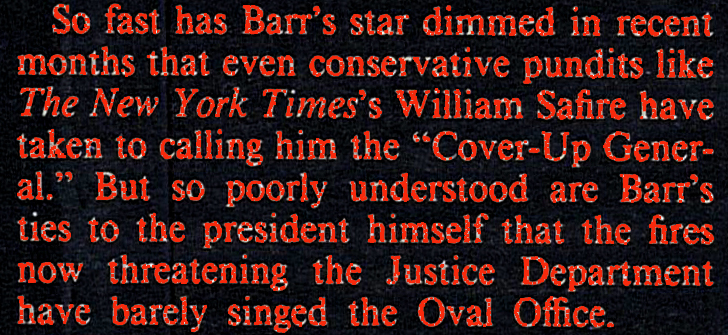
THE EDMUND BURKE CLONE ASCENDENT
During the 1980s Barr bounced between government service and a prestigious Washington law firm that would later represent one of the key defendants in the BCCI affair. Barr assured Congress in 1991 that he was long gone from Shaw, Pittman, Potts & Trowbridge by the time it took on its dubious BCCI client. Still, the appearance of compromised interests would dog Barr at Justice, particularly as its own investigation of BCCI stalled.
“Like your typical Wall Street lawyer… not a table pounder” was how one of Barr’s legal sparring partners remembered him during his days at Shaw, Pittman. Indeed, “corporate” was written all over him. Though he never tried a case in court, he took on the causes of some of the firm’s starchiest clients, including a nuclear utility in a whistleblower case.
Briefly, in 1982, Barr left the firm for a stint in the White House’s Office of Policy Development. Congress took no action on his two main portfolios, abortion and tuition tax credits for low-income parents of private school students. But he did strike up a useful friendship with White House Counsel C. Boyden Gray. This relationship would later help propel Barr to the top spot at Justice and nurture speculation among critics that he was a White House toady.
In 1983 Barr returned to law practice and laid low for the next five years, thus avoiding the Iran-contra tar baby. But as Bush launched his presidential bid in 1988, Barr joined the campaign team and, among other things, helped fend off attacks on Dan Quayle’s character. His loyalty was quickly repaid. In late 1988, Barr became the first assistant attorney general to be installed in the wake of the election.
He also began flexing his ideology in public. During a congressional hearing at the time he boldly acknowledged having “doubts” about the constitutionality of the independent counsel statutes because of what he saw as their limiting effect on presidential power.
For the next two years, as chief of the Justice Department’s Office of Legal Counsel, Barr played a key role in shaping Richard Thornburgh’s stormy tenure as attorney general. In a job that was essentially political, he helped maintain the administration’s ideological purity by screening out judicial candidates who weren’t conservative enough. He also drafted two key documents rationalizing the U.S. invasion of Panama and the seizure of General Manuel Noriega.
If Barr had made no other contribution to the imperial pretensions of George Bush, these documents would nevertheless qualify him for hero status in the Republican pantheon. The first “opinion,” written in June 1989, recognized the president’s right to dispatch FBI agents abroad to arrest foreigners even in violation of international treaties. The second document, issued the following December as American forces geared up to invade Panama, gave a patina of legality to the president’s desire to use the military in similar takedown operations. Together, the two memos enshrine what has come to be known as the president’s “snatch authority.”
In an inevitable seignorial flourish, the administration refused to release the complete contents of these documents, even to Congress. But over the years, enough of their flavor has seeped into the press to take one’s breath away. Writing in the June memo, Barr argued that both the president and, through him, the attorney general have an “inherent constitutional power” to authorize certain overseas operations, including abductions, to fend off “serious threats” to U.S. domestic “security” from “international terrorist groups and narcotics traffickers.” Such actions, he said, are mandated by the Constitution and domestic law and can be undertaken even in the face of objections from a foreign government or provisions of the UN Charter barring the use of force against member nations.
When Congress first got wind of these astonishing theories, in November 1989, Barr insisted that they represented no policy change. But weeks later, the Panama invasion kicked off, and the following spring federal agents infuriated the Mexican government by arranging to have a Mexican doctor, who had helped torture and murder a DEA agent, abducted and spirited to the U.S. Three years later, the U.S. Supreme Court took up the legality of that action. Though the conservative majority approved it on the grounds that our extradition treaty with Mexico did not specifically bar kidnapping as a law enforcement tool, Justice John Paul Stevens, in dissent, seemed to be speaking for many Americans when he decried the ruling as “monstrous.”
“It is shocking” he wrote, “that a party to an extradition treaty might believe it has secretly reserved the right to make seizures of citizens in the other party’s territory.”
IN THE RIGHT PLACE AT THE RIGHT TIME
From the moment the “snatch” memos became news, nobody on Capitol Hill seemed in doubt about their authorship. But surprisingly, the rancor didn’t rub off. Somehow Barr kept even his critics convinced that he was a conciliator, the type of moderate conservative you wouldn’t mind having to dinner. Journalists tell the story of how on the eve of the Panama operation he charmed the guests at a Thornburgh Christmas party by showing up in kilts with bagpipes under his arm to play for hours. Where Thornburgh rankled, Barr soothed. For an administration increasingly beset by scandal and economic malaise, this capacity for the light touch proved a valued asset.
In mid 1990, as Thornburgh’s own problems with Congress deepened, Barr was tapped to run interference, and was named deputy attorney general. The appointment came just in time for him to draft another landmark tract for the administration, the legal pretext for the undeclared war against Iraq. It would have made any Nixonite proud. Explaining it later to Congress, Barr said he believed there was a “gray zone” between a declared offensive war and an emergency defensive action where “there is latitude for the president, if he believes that the vital interests of the United States are threatened by foreign military attack, there is room for him to respond.”
Barr did not make clear how the Iraqi invasion of Kuwait equaled an attack on vital American interests, but to his credit, at the moment of decision itself, he did counsel the president to soften the impact of his unilateral rush to war by seeking a declaration of congressional support. That piece of advice, much akin to Johnson’s leveraging of the Tonkin Gulf resolution, helped to keep the naysayers at bay.
Barr’s service to the administration, however, wasn’t limited simply to such flashes of political savvy. In 1991 he became active in stone-walling the Iraqgate and the BCCI investigations and further gratified conservatives by keeping up the tattoo on their favorite hot-button issues. Embracing immigration policy as his own, he helped craft an exception rule that automatically barred HIV-positive sufferers from entering the country. Civil libertarians charged illegal discrimination and even racism, since many of those excluded were black Haitians. Barr assured Congress that the policy was meant only to keep out people who might be thrown back on public welfare.
Flogging another conservative hobbyhorse, Barr fought hard as deputy AG to keep federal courts from expanding their right to review state criminal convictions on writs of habeas corpus. As a devout Catholic, he also pandered to the antiabortion crowd, even “torquing” the law in August 1991 to advance their crusade. The challenge came when a federal judge in Wichita issued an order barring anti-abortion demonstrators from blocking access to a clinic. The Justice Department intervened to try to force a lifting of the ban. Later asked about this by Congress, Barr gave an exquisitely technical rationale, asserting that though the demonstrators were “lawbreakers… treading on other people’s rights,” they “should be dealt with” in state court, not federal court — thus the federal judge’s order was unenforceable.
It was vintage Barr, a neat fileting of the law for a political end. Democratic predecessors had done the same. But what made Barr an irritant to critics was his adeptness at it.
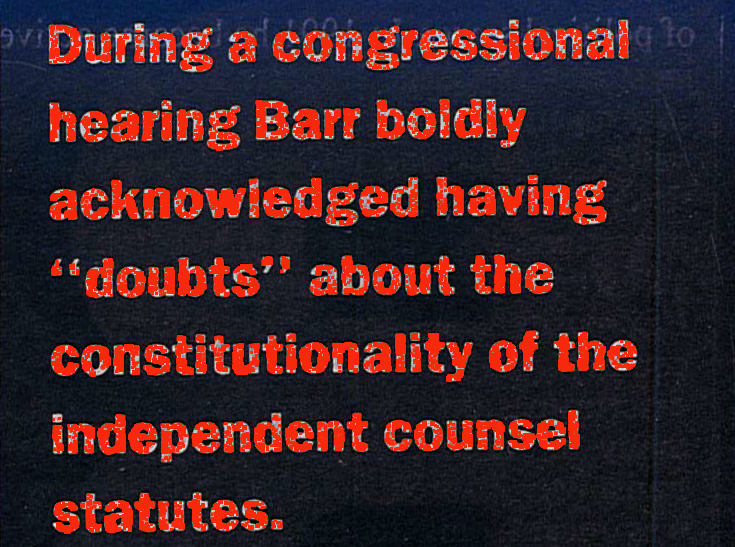
ATTORNEY GENERAL AT LAST
If any single event assured Barr’s final ascendancy, it was the Anita Hill-Clarence Thomas confrontation. At his confirmation hearings in November 1991 Barr admitted that Justice’s Office of Legal Counsel had gathered evidence against Hill and communicated with her congressional critics, but he denied any impropriety. “It is my understanding,” he testified, “that OLC lawyers did not go proactively to investigate Anita Hill… [but] performed the traditional role of lawyers, which was to take the information coming in, transcripts, statements, and so forth and analyze them.”
Democratic senators were not convinced, but because the Hill-Thomas fight had been so bitter — and because no one wanted a replay of the fractious hearings that had greeted Robert Gates’s bid to become CIA director — Congress cleared Barr’s nomination with barely a protest.
When Barr finally moved into the AG’s chair in late 1991, he talked tough about combatting drugs and crime and immediately shifted 300 FBI agents from counter-intelligence work to antigang and violent-crime squads. In addition, an inner-city program that he dubbed “Weed and Seed,” aimed at weeding out violent criminals and revitalizing neighborhoods, was soon elevated to administration policy.
For all the fanfare, however, critics sensed little more than smoke and mirrors. The Noriega conviction, which Barr touted as a major blow to narcotrafficking, produced no slackening of the drug flow through Panama. Moreover, the Rodney King affair and the subsequent L.A. riots exposed a glaring contradiction in the department’s get-tough policy on crime.
Responding to the acquittal of King’s police attackers, Barr empaneled a federal grand jury to investigate. But, lest he offend Bush’s law-and-order constituency, he continued to stall off other initiatives. Over a year ago, Representative Don Edwards introduced a bill making it a federal crime for a police officer to engage in a “pattern” of excessive force and empowering victims to sue to stop such abuses. But under the hammering of Justice and some friendly senators, the still-pending bill lost its teeth, degenerating into a simple authorization that would permit the attorney general himself to sue offending police departments.
On top of this, Justice officials have pigeonholed until after the election two long-promised, potentially explosive studies of 15,000 police brutality complaints from across the-country. The delay outrages black leaders, who fear further frustration and violence. “The department’s response to this issue has been totally inadequate,” the NAACP’s Washington director Wade Henderson recently told the Legal Times.
On other fronts, displays of partisan excess under Barr’s stewardship are becoming bolder, more transparent. Last summer, in deference to the administration’s anti-regulation agenda, the attorney general himself overruled the EPA and his own staff and wrote an interpretation of the Clean Air Act that dismantled its most important pollution regulation. He also took another imperious swipe at the immigration issue by helping devise a new policy that authorizes the Coast Guard to intercept Haitian refugees on the high seas and return them to their island. The initiative was a response to the flood of refugees unleashed by the military coup in Haiti last fall. But human rights organizations have gone to court to challenge its legality, declaring that it violates UN protocols that forbid the repatriation of those who face political persecution at home. “It is another example,” says human rights lawyer Michael Ratner, “of the Barr regime flouting the law for political ends.”
The truest measure of Barr’s extremism, however, lies in the coils of three unfolding national scandals. The central question they pose is: How far will he go to protect his master? The answer, some feel, already exposes Barr to the risk of a grand jury investigation and maybe worse.
BCCI
Nobody knows how much the American taxpayer has lost in the BCCI affair, but after years of start-stop investigations it is apparent that federal authorities knew as early as 1983 that the London-based Bank of Credit & Commerce International was trying to buy into the American banking system illegally, even as it engaged in a variety of crimes abroad.
Why the Justice Department was so slow to step in has never been adequately explained. Some accuse Thornburgh and Barr of trying to cover up BCCI links to Irancontra and the CIA, which has admitted using the bank’s facilities abroad in covert operations. No substantiation has been found for this charge, but few doubt that a stall-off did occur at Justice.
The initial culprit appears to have been the CIA, which, though aware early on of BCCI’s inroads into American banking, chose not to inform the attorney general. Even so, by 1988 the violations were so blatant that Senator John Kerry stumbled on them while heading up a subcommittee on drug trafficking. He alerted the Justice Department — to no avail. Later, a Customs bust prompted indictment of some BCCI officials in Tampa, but inexplicably the Justice Department pursued only low-level prosecutions, while leaving top BCCI officials untouched.
Finally, in July 1991, banking authorities worldwide moved to shut BCCI down. Deputy Attorney General Barr admitted to Congress at the time that there had been “coordination” problems in the investigation and promised to remedy them. But a top federal prosecutor in Miami later accused Barr and other Justice officials of repeatedly thwarting his own efforts in 1991 to indict the bank of fraud charges.
What broke the logjam was Senator Kerry’s own impatience. Frustrated with Justice’s inaction, he eventually had one of his investigators, Jack Blum, turn some dirt on BCCI over to New York state district attorney Robert Morgenthau, who promised an investigation of his own. That did it. In December 1991, the Justice Department joined Morgenthau in announcing a plea arrangement with BCCI that nailed the bank for various criminal violations and obligated it to fork over $550 million, the largest criminal forfeiture ever obtained by the government. Last July, Morgenthau and federal attorneys in New York dropped the other shoe, announcing the indictments of Democratic Party patriarch Clark Clifford and his law partner on charges of lying to banking regulators, bribe-taking, and falsification of records — all in service of their onetime client, BCCI. Both men pleaded not guilty.
Barr gloated, declaring after the initial plea agreement that this “resolves all United States charges against BCCI as an institution.” But Senator Kerry’s own analysis of the scandal, released only a few weeks ago, makes clear that the Justice Department’s investigation of BCCI was often too little, too late.
Says Blum, whose approach to Morgenthau levered Barr into action: “Justice’s handling of BCCI gives the lie to the adminstration’s claim to being hard-line on crime.”
INSLAW
Barr has long been a critic of the independent counsel law and has argued that Justice officials are professional enough to investigate themselves and their own masters. But a report on the Inslaw affair, released in September by Representative Jack Brooks’s Judiciary Committee, obliterates that claim.
At issue is whether the Justice Department itself stole valuable computer software from the Washington-based Inslaw company in the early 1980s. Four years ago, a lawyer for Inslaw called for the appointment of an independent counsel to investigate, but Thornburgh resisted, and at his own confirmation hearings in November 1991 Barr announced that he was naming an in-house counsel under his own control to handle the inquiry. According to the recently released Brooks report, that investigation has yet to bear fruit in part because Barr delayed granting his appointee subpoena power.
Even worse, says the report, Justice officials stonewalled the committee’s own efforts to get at the facts, by blocking access to witnesses, and by denying and even “losing” relevant documents. The report blames this “lack of cooperation” for the tentativeness of its own conclusions, but leaves little doubt where the committee’s sympathies lie. Pointing out that Justice officials concluded as early as 1986 that Inslaw’s claim to the disputed software was “legitimate,” the report says the department nonetheless spent $1 million fighting the issue in court, thus raising the “spectre” of “an abuse of power of shameful proportions.”
“The Department of Justice is this nation’s most visible guarantor of the notion that wrongdoing will be sought out and punished irrespective of the identity of the actors involved,” the report concludes. “The Department’s handling of the INSLAW case has seriously undermined its credibility and reputation in playing such a role.”
IRAQGATE
Last week the chair of the Senate Intelligence Committee lent his voice to a chorus already calling for an independent counsel to investigate how the Justice Department, CIA, and FBI bungled a case in Atlanta involving $5 billion in illegal loans to Iraq. Over a month ago, William Barr rebuffed a similar congressional request and bridled at suggestions that his department couldn’t handle the inquiry itself. But since then, the CIA has accused one of Barr’s subordinates of having “strongly advised” that relevant intelligence be withheld from the federal judge in Atlanta who until recently was handling the case. In response, Barr has just announced that he’s appointing a special prosecutor — a Republican judge — to investigate under Justice Department supervision. It’s precisely the kind of stall tactic Barr used so effectively in the INSLAW affair.
In basic terms, the controversy is over the classic cover-up question of who knew what when — and bears critically on the most sensitive foreign policy issue of the Bush presidency, the coddling of Saddam Hussein prior to the Gulf War.
To be up to speed, you have to understand a few arcane facts. First, the administration is accused of having allowed U.S. agricultural loan guarantees to be used to underwrite military purchases by Iraq during the late 1980s when the official policy was: moderate through conciliation. Second, the Atlanta branch of the Italian bank Banca Nazionale del Lavoro is said to have floated $5 billion in illegal loans to Iraq during the same period. Third, the Justice Department is suspected of having deliberately singled out BNL’s Atlanta branch manager for prosecution, saying he acted alone, so as to avoid embarrassing his higher-ups in Rome and opening a can of worms that could reveal deeper administration complicity in the funding of Iraq’s military buildup.
Along the way, evidence has surfaced that the Commerce Department altered documents that pointed to the dual use (read: military) applicability of certain items the Iraqis had purchased with U.S. aid.
Still awake? Please, there’s more. In February 1991, the Justice Department struck a plea agreement with the BNL manager in Atlanta that pledged him to clam up, making no statement in court, in exchange for having the charges against him lessened. Members of the Senate Judiciary wondered: what gives? So did the Atlanta federal judge, Marvin Shoob, who late last summer was about to sentence this apparent fall guy. Shoob called for an independent counsel to sort out the mess.
That’s when the bureaucrats began quick-stepping. On September 4, the CIA sent the Justice Department a classified letter that glossed over early intelligence reports indicating top-level knowledge within BNL Rome of the Atlanta branch’s illicit Iraqi loans. Ten days later, House Banking committee chair Henry Gonzalez, who’d previously goaded the CIA into giving him the facts, spilled them in a speech on the floor of the House. Inevitable conclusion: the U.S. intelligence community knew, by late 1989, that BNL from top to bottom had played fast and loose with American banking regulations. Why, then, such a delay in prosecution?
The CIA continued to duck and weave, claiming in a letter to Shoob on September 17 that nobody knew nothin’ about the early intelligence reports implicating BNL-Rome in the scandal.
As the heat intensified, however, so did the weakness in bureaucratic knees. On October 8 CIA lawyers, testifying to the Senate Intelligence Committee, declared that a devil at Justice had made them do it – that one of Barr’s subordinates had encouraged them to skimp the truth in the letter to Shoob. Justice officials struck back by playing victim. How do you suborn the CIA? they demanded publicly. The CIA again parried by claiming that the early tell-all intelligence reports fingering BNL-Rome had been known to FBI and thus Justice officials since late 1989. Barr in turn ordered FBI chief William Sessions investigated on unrelated ethics charges — a probe that some see as an attempt to buffalo the Bureau at the very moment it might be tempted to investigate Iraqgate on its own.
You can’t be awake. But what’s important is this: The Justice Department stands accused by the nation’s premier intelligence agency of having abetted the cover-up of a possible crime, even to the point of shaving evidence. Maybe this simplifies it, but the allegation itself should give pause even to the most devout law-and-order conservative. And no, this ain’t a mugging, baby. The lawlessness espoused in Barr’s snatch memos inevitably breeds offspring.
There is, too, the more basic issue of equity: Imagine you’re the manager of Atlanta’s BNL branch who’s wound up in Barr’s cross hairs because the Justice Department and everybody else in the Bush administration needed a scapegoat for their own policy errors. On October I he did get a reprieve of sorts: The Justice Department decided to try him rather than embarrass itself further by sticking with the plea agreement that so artfully found him guilty without giving him a chance to speak. Even so, if you’re in his shoes, do you place any stock in American justice? Or, as one critic said of the snatch memos, do we have here a regime of law that says: when the president declares it’s illegal, it is? ■
Related front page panorama photo credit: Adapted by WhoWhatWhy from Ronald Reagan Presidential Library / Wikimedia and The White House / Flickr.
